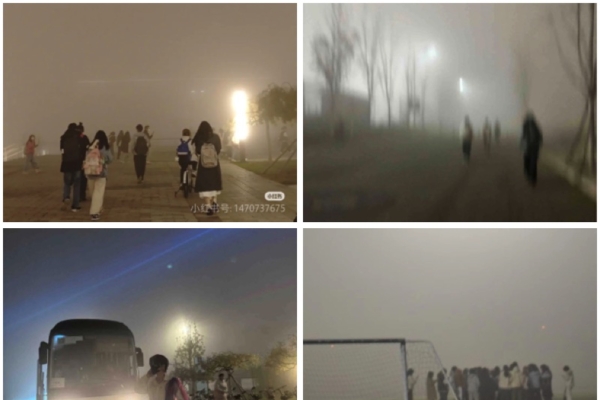In recent days, Beijing has been experiencing severe pollution with thick smog, leading to extremely poor visibility and causing flight delays and cancellations at the airport. However, the Chinese state media deliberately omitted the term “smog” and referred to it as “severe fog yellow alert.” On November 3rd, despite the yellow alert still in effect, a marathon with 30,000 participants was held in front of Tiananmen Square, drawing criticism from Beijing residents.
Since the Central Meteorological Observatory issued a severe fog yellow alert on the afternoon of October 30th, they continued to issue the alert for several days until November 3rd, warning of thick fog with visibility below 500 meters in some areas and strong fog with visibility below 200 meters in localized areas.
November 2nd was the most severe, with Beijing implementing temporary closures on several highways, including full closure of sections of the Beijing section of the Beijing-Kunming Expressway, the North Line Expressway of Daxing Airport, and the Beijing section of the Capital Ring Expressway. As a result, some flights at Beijing Capital Airport and Daxing Airport were delayed or canceled.
A university student from southern China studying at Minzu University of China in Beijing remarked, “On the evening of November 2nd, the scene outside the library was like a blurred mess within five meters, which was a big shock for someone from the south.”
Large lightboxes were displayed on major roads in Beijing, reminding people to “take precautions and arrange travel properly during severe fog yellow alerts.”
On November 1st, a Beijing resident joked on social media, “Beijing under severe fog yellow alert, absolutely cannot say it’s smog.”
Reflecting on his one-week stay in Beijing from October 25th to November 1st, the resident expressed disappointment with the continuous hazy weather and noted feeling unwelcome due to the serious air pollution affecting his health.
Beijing residents have been openly questioning why authorities refuse to acknowledge the presence of smog and only refer to it as fog. Many netizens and locals directly refer to the situation as smog. Mr. Wang, a resident of Daxing District in Beijing, mentioned that there was smog in the area for several days, but the weather had improved on the 3rd, albeit with the onset of strong winds.
Similarly, Mr. Hua from Chaoyang District in Beijing commented on the severe smog in the past days with poor visibility and uncomfortable air quality, but he noted an improvement in the weather on the 3rd with the onset of windy conditions.
Another resident shared his experience of going out in the heavy smog, mentioning the difficulty in breathing due to the thick haze and the presence of paper burning rituals for the deceased, indicating the challenging living conditions in Beijing.
Despite the official statements avoiding the term “smog,” individuals across China continue to identify the situation as smog. Environmental reports on Beijing’s air quality have used the term “smog,” highlighting the prolonged and severe pollution affecting the Beijing-Tianjin-Hebei region.
Concerns have been raised by Beijing residents regarding the sources of pollution, especially since many steel mills and polluting industries have relocated from the city. Some parents noted early warnings from kindergartens about outdoor activities being suspended due to the expected heavy pollution, highlighting the impact on children’s health and activities.
Amidst growing uncertainty and health concerns, residents have questioned the lack of transparency from authorities regarding the origins of the pollution. Recent chemical leaks in Qinhuangdao, Hebei Province further fueled speculations about potential air contamination and its adverse effects on public health.
Despite the continuous severe fog yellow alerts issued by the Central Meteorological Observatory on November 3rd, the marathon with 30,000 participants in Beijing went ahead as scheduled on the same day, sparking mixed reactions and debates online.
The marathon event, featuring participants from all over the country, was met with both humor and criticism on social media platforms, with some viewing it as a positive act to “purify the air” and others condemning it as a reckless endangerment of participants’ health.
The ongoing environmental challenges and health risks posed by the persistent smog in Beijing have prompted residents to voice their concerns and doubts about the authorities’ handling of the situation. The harmful effects of inhaling particulate matter have raised fears of respiratory illnesses and long-term health implications, underscoring the urgent need for effective pollution control measures and public health awareness in the region.

